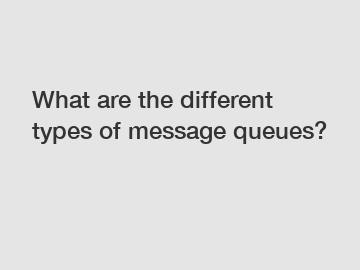Jan. 19, 2024
Business Services
Vanus Product Page
In today's fast-paced digital era, efficient data processing and seamless communication are critical for any successful application or system. Message queues play a vital role in facilitating asynchronous communication, enabling message delivery between different components or services. With a plethora of message queue types available, understanding the differences and selecting the most suitable one for your needs can be a challenging task. In this article, we will explore various message queue types, their unique characteristics, and use cases.
1. Simple Queue:

This is the fundamental type of message queue, where messages are stored in a queue and processed by a single consumer. It follows the First In, First Out (FIFO) principle, ensuring that messages are processed in the order they arrive. Simple queues work well for applications with low message volume and straightforward processing requirements.
2. Work Queue:
A work queue, also known as a task queue, introduces the concept of load balancing to distribute tasks among multiple workers. It enables parallel processing and allows scaling the number of workers depending on the workload. Work queues are suitable for managing long-running or resource-intensive tasks, enhancing application responsiveness, and improving overall performance.
3. Publish/Subscribe:
The publish/subscribe (pub/sub) pattern enables one-to-many communication, where a message is sent to multiple subscribers. In this setup, publishers generate messages, and subscribers consume them independently. Pub/sub queues are ideal for scenarios involving event-driven architectures, real-time updates, and broadcasting information across multiple systems or endpoints.
4. Request/Reply:
As the name suggests, the request/reply pattern involves two participants: the requester and the responder. The requester sends a message to a specific queue, expecting a response from the responder. This type of message queue is suitable for synchronous communication, where the requester needs immediate feedback for further processing. Request/reply queues are commonly used in client-server architectures and RPC-style communications.
5. Dead Letter Queue:
In complex systems, it is essential to handle exceptional scenarios and ensure message reliability. Dead letter queues act as a safety net by collecting messages that failed to be processed within a certain timeframe or encountered errors during processing. These queues provide an opportunity to investigate and analyze failed messages, leading to error resolution and system stability improvements.
6. Priority Queue:
In environments where message importance varies, priority queues come into play. They assign different priorities to messages, ensuring higher-priority messages are processed first. This type of queue facilitates the processing of urgent or time-sensitive messages, optimizing system performance and user experience.
7. Delay Queue:
Sometimes, it is necessary to introduce a delay before processing certain messages. Delay queues hold messages for a specified duration before making them eligible for consumption. Delay queues are useful for implementing deferred actions, scheduled tasks, or scenarios where data consistency is critical.
Conclusion:
Message queues are the backbone of modern distributed systems, enabling reliable and scalable communication between components. Choosing the right type of message queue depends on your specific application requirements, the desired level of scalability, and the nature of the data being processed. By understanding the different types of message queues available, you can make informed decisions and build robust and efficient systems.
In this article, we explored various message queue types, including simple queues, work queues, publish/subscribe queues, request/reply queues, dead letter queues, priority queues, and delay queues. Each type caters to unique scenarios and provides distinct benefits. By leveraging the power of message queues, developers can enhance the performance, reliability, and overall user experience of their applications.
For more Event Streaming Platform Vs Message Queueinformation, please contact us. We will provide professional answers.
If you are interested in sending in a Guest Blogger Submission,welcome to write for us!
All Comments ( 0 )